When it comes to archery, the types of arrows you choose can greatly impact your performance and success. There is a wide variety of arrows available, each with its own unique characteristics and purposes.
There are many different types of arrows available for every type of archery and bow, including traditional arrows, competition arrows, and hunting arrows. Arrows are also made from a variety of materials including, wood, aluminium, carbon, and fibreglass.
In this comprehensive guide, we will delve deep into the different types of arrows and explore their features to help you make an informed decision.
Types of Arrows: An In-depth Exploration
Target / Competition Arrows
When it comes to archery, precision is the name of the game. And that’s where target and competition arrows come into play. These specialized arrows are designed with one goal in mind: hitting the bullseye with the utmost accuracy.
They are most commonly used in Field and Target archery but are also great for use in 3D archery.
Whether you’re a beginner or an experienced archer, investing in high-quality target arrows can greatly enhance your performance on the range.
Hunting Arrows
When it comes to hunting, choosing the right arrows can make all the difference in your success.
Hunting arrows are specifically designed to deliver optimal penetration and accuracy, ensuring a clean and ethical harvest.
There are various factors to consider when selecting hunting arrows, including weight, broadhead compatibility, and construction materials.
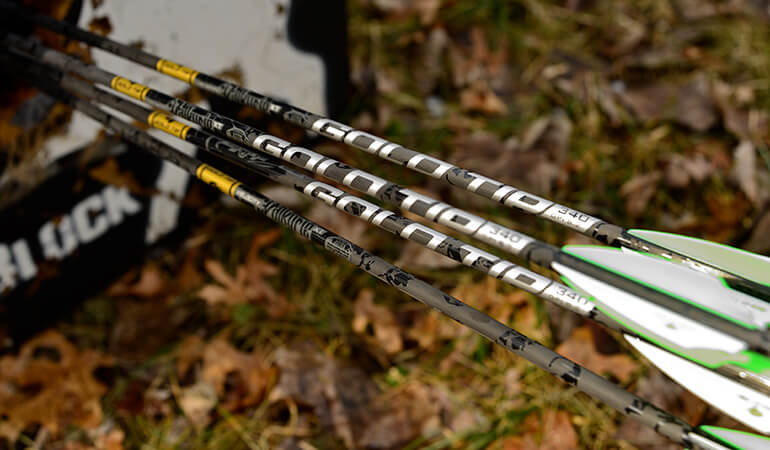
One crucial aspect of hunting arrows is their weight.
Heavier arrows tend to penetrate better, making them a popular choice among hunters. The added weight provides more kinetic energy upon impact, increasing the chances of a quick and humane kill.
However, it’s important to find a balance between arrow weight and the capabilities of your bow.
For instance, if you have a lower-poundage bow, using excessively heavy arrows may lead to reduced speed and trajectory accuracy.
Consulting with experienced hunters or archery professionals can provide valuable insights into choosing an arrow setup that maximizes your chances of success in the field.
Traditional Arrows
Traditional arrows in the world of archery have an undeniable charm and appeal. They are associated with the art and skill of traditional archery, prioritizing simplicity and elegance over modern advancements.
One notable characteristic of traditional arrows is their construction. Unlike carbon arrows used in compound and modern archery, traditional arrows are typically crafted from natural materials like wood or bamboo.
These organic materials not only enhance the aesthetic appeal but also provide a distinct shooting experience.
Traditional archers often take pride in handcrafting their wooden arrows, carefully selecting and working on each piece.
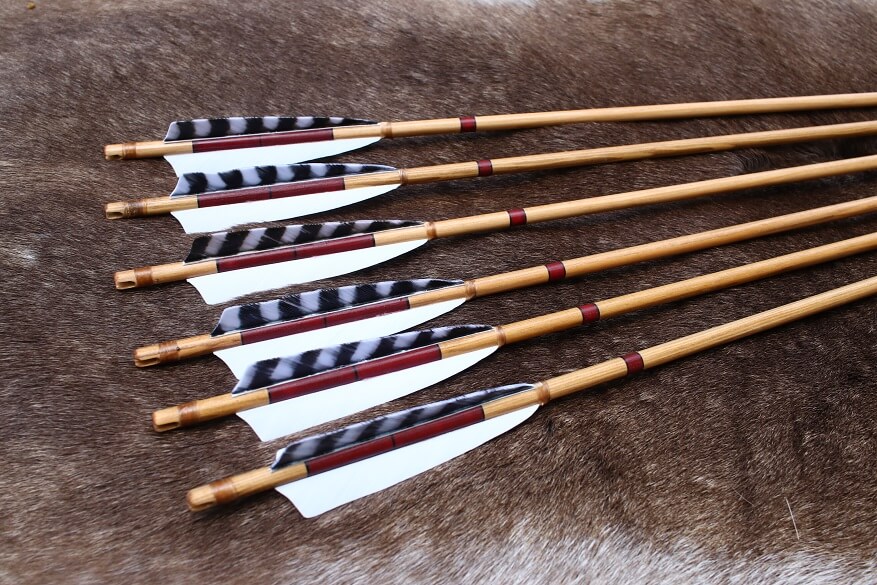
Another aspect that sets traditional arrows apart is their design. These arrows usually feature feather fletching rather than plastic vanes seen on compound bow arrows.
Feathers provide an unparalleled level of stability and accuracy during flight due to their natural ability to adapt to air currents.
Additionally, compared to carbon or aluminium shafts commonly found in modern archery equipment, wooden shafts add a touch of authenticity and character.
Traditional bows such as longbows or recurve bows pair exceptionally well with these classic arrows.
Shooting traditional arrows provides enthusiasts with an authentic connection to history and an opportunity to refine their skills in this ancient art form.
If you desire nostalgia or a deeper connection to archery’s roots, traditional arrows are an excellent option.
Their natural materials, handcrafted beauty, and timeless design transport you to the world of traditional archery unlike any other arrow type.
So, grab your longbow or recurve bow and let these charming wooden wonders take flight as you embrace the artistry of traditional archery.
Flu-Flu Arrows
Flu-flu arrows are a unique and fascinating type of arrow that brings a whole new level of excitement to the world of archery.
These arrows are specifically designed to be used in situations where you want to limit the distance your arrow can travel.
The distinguishing feature of flu-flu arrows is their oversized fletching. Instead of the standard-sized fletching that you find on most arrows, flu-flu arrows have much larger feathers or vanes.
These oversized feathers create a significant amount of drag, which causes the arrow to lose speed and altitude rapidly after it is shot.

This decrease in distance travelled makes flu-flu arrows perfect for shooting in dense areas or when you need your arrow to stop quickly without going too far.
When it comes to using flu-flu arrows, they offer a wide range of applications. One popular use is in aerial archery, where archers shoot at targets thrown into the air.
Flu-flu arrows stand out with their large fletching, which enhances visibility and makes tracking them in flight easier.
These arrows are particularly popular for recreational shooting at shorter distances and even for hunting small game like birds or squirrels.
The limited range of flu-flu arrows increases the likelihood of retrieving the arrow after hitting the target.
It’s worth noting that while flu-flu arrows have their advantages, they may not be suitable for every archery situation.
Due to their design, these specialized arrows are less accurate than standard ones at longer distances since they lose stability quickly due to increased drag from their oversized fletching.
Ideal Arrows for Different Bows
Each type of bow has unique characteristics that can influence the type of arrow you should use.
- Recurve Bows:
Recurve bows have curved limbs that store and release energy more efficiently compared to other bow styles.
These bows are often used in Olympic and traditional archery. Recurve arrows are typically longer and have more flexible shafts to match the longer draw length of recurve bows and absorb the energy from the bow effectively. - Compound Bows:
Compound bows feature a system of cables and pulleys, which allows for a high let-off and easier holding at full draw.
They generate more speed and power compared to other bow styles. Compound arrows are usually shorter and stiffer to accommodate the faster arrow release and handle the higher draw weight and energy transfer of compound bows. - Traditional Bows:
Traditional bows, such as longbows and self-bows, have a simple design without mechanical components.
They require more strength and technique to shoot effectively. Traditional arrows are often made from natural materials like wood and feathers and are matched to the draw weight and shooting style of the particular traditional bow being used.
Designers tailor each arrow type to enhance performance and accuracy with its matching bow style.
They carefully consider factors like arrow length, spine (stiffness), weight, and fletching configuration. This ensures the arrow flies correctly and the bow transfers energy to the arrow effectively.
Using the appropriate arrow type for a specific bow style helps archers achieve better consistency, accuracy, and overall shooting performance.
Best Types of Arrows for Recurve Bows
When it comes to choosing the right type of arrows for your recurve bow, there are a few options that you should consider. One popular choice among archers is carbon arrows.
Carbon arrows are known for their durability and strength, making them suitable for both beginners and experienced archers.
These arrows are lightweight, which allows them to fly faster and flatter, resulting in improved accuracy.
Additionally, carbon arrows have a smaller diameter compared to other types of arrows, reducing wind resistance and increasing their performance.
Another option for recurve bow users is aluminium arrows.

While they may not be as strong as carbon arrows, aluminium arrows offer great versatility and affordability. These arrows can withstand high impact without breaking easily, making them a solid choice for target shooting or recreational use.
They come in various lengths and spines to suit different draw weights of recurve bows. One important thing to note is that aluminium arrows can bend if subjected to significant stress or improper handling.
Therefore, it’s essential to regularly inspect your arrow shafts for any signs of damage. For those who prefer a more traditional touch to their archery equipment, wooden arrows are an excellent option for recurve bows.
Wooden arrows have been used in archery for centuries and continue to be cherished by many traditional archery enthusiasts today.
They offer a unique combination of aesthetics and performance while providing a certain level of nostalgia during each shot.
Wooden arrow shafts can be made from various types of woods such as cedar or spruce, each offering its own characteristics in terms of weight, stiffness, and durability.
Consider factors such as personal preference, intended use (target shooting or hunting), and budget when making your decision.
Best Types of Arrows For Compound Bows
Compound bows are known for their power and speed, so it’s important to select arrows that can handle the force generated by these bows.
Carbon arrows are a popular choice for compound bow archers due to their strength and durability.
They can withstand high-speed impact without breaking or bending, ensuring accurate shots time after time.
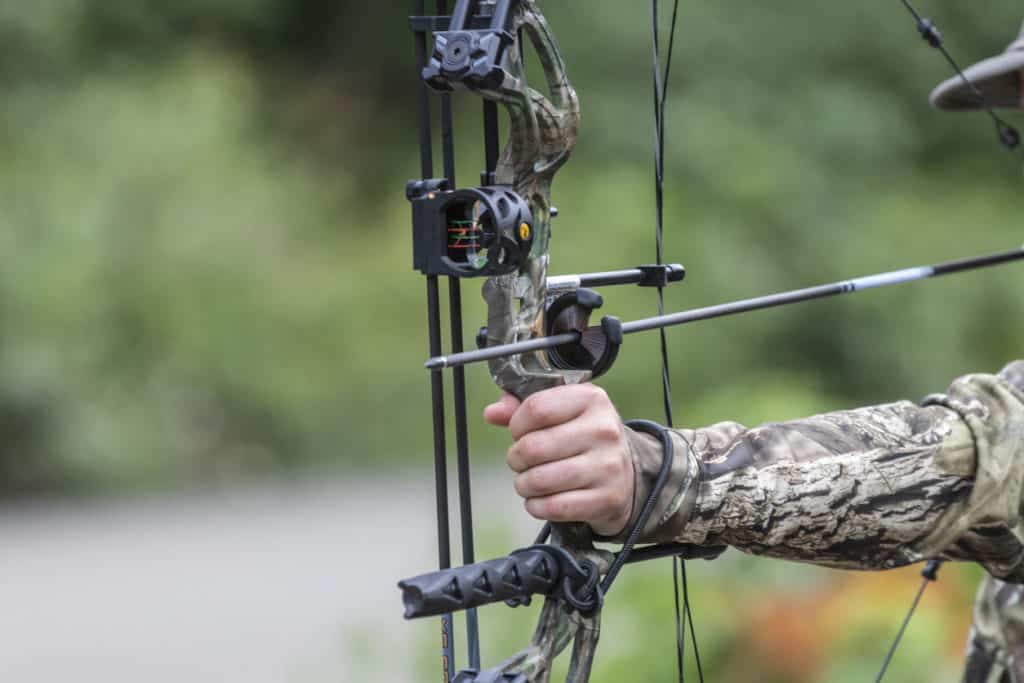
Recurve bow arrows are not typically recommended for use with compound bows. Recurve arrows have a different design and spine stiffness that may not be suitable for the higher draw weight and speed of a compound bow.
Using recurve arrows with a compound bow could affect the accuracy and potentially damage the arrow or even your equipment.
When selecting arrows for your compound bow, carbon arrows designed specifically for this type of modern archery equipment provide excellent performance and durability.
It’s best to avoid using recurve arrows as they may not handle the force generated by a compound bow adequately.
Best Types of Arrows for Longbows
Longbows are known for their elegance and historical significance in archery, so it’s important to choose arrows that match their traditional appeal.
Traditional archery arrows, which are often made from wood, are a popular choice for longbow enthusiasts.
The wooden shafts not only provide an authentic feel but also offer a smooth release and excellent flight.
However, if you prefer modern materials without compromising on performance, carbon arrows can be an excellent option for your longbow.
Carbon arrows are lightweight yet incredibly strong, allowing them to withstand the high draw weight of longbows.
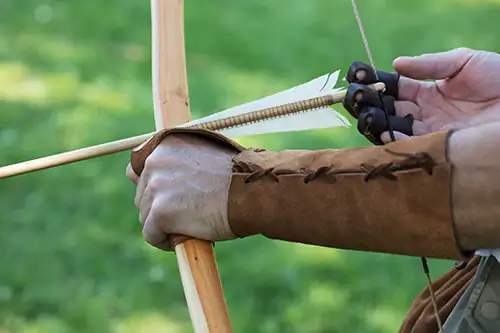
These arrows provide exceptional accuracy and speed while maintaining durability, making them suitable for both target shooting and hunting.
Adding feather fletching to your arrows can improve stability during flight due to its natural ability to correct arrow rotation.
This can contribute to tighter groupings and improved accuracy when shooting with a longbow.
Choosing the appropriate arrows for your longbow is essential to achieve peak performance and accuracy while respecting archery traditions.
Traditional wooden shafts can provide an authentic feel and a smooth release. On the other hand, carbon arrows offer strength and precision without compromising the historical charm.
When it comes to choosing the right type of arrows, one essential aspect to consider is the material of the arrow shaft.
The arrow shaft is the main body of the arrow, and different materials offer distinct advantages and characteristics.
Carbon
Carbon arrows have gained significant popularity in recent years due to their lightweight and durable nature.
They are known for their excellent flight performance, accuracy, and consistency.
| Characteristics | Details |
|---|---|
| Strength-to-Weight Ratio | Light but very strong, which allows for faster arrow speeds and flatter trajectories |
| Straightness | Maintain their straightness over time, which aids in accuracy |
| Durability | Resistant to bending and breaking, suitable for various types of archery, including hunting |
| Consistency | Made with a high degree of consistency, which helps in maintaining accuracy shot after shot |
| Cost | Typically more expensive than wood or aluminum arrows but provide superior performance |
Carbon arrows have become a go-to option for many archers, whether they are shooting recurve bows or compound bows.
These arrows come in various spine options to suit different draw weights and bow setups.
Additionally, carbon arrows can be fitted with a wide range of accessories like fletchings, nocks, and broadheads.
Aluminium
Another common material used for arrow shafts is aluminium.
Aluminium arrows have been around for quite some time and continue to be a preferred choice among traditional archers.
| Characteristics | Details |
|---|---|
| Weight | Heavier than carbon, which can be advantageous as they are less affected by wind |
| Cost | Typically cheaper than carbon arrows, making them a popular choice for beginners or those on a budget |
| Durability | Not as durable as carbon or fiberglass, they can bend if they hit a hard object |
| Straightness | Generally very straight and maintain their straightness well |
| Versatility | Suitable for a range of archery types, including target archery and hunting |
These arrows offer good durability, consistency, and versatility across various types of bows such as longbows or recurve bows.
Aluminium arrows can also be easily customized with various components to meet individual preferences.
Wood
If you desire a traditional feel or wish to embrace the historical elements of archery equipment, wooden arrow shafts can be an appealing choice.
Wooden arrows possess a unique charm that connects us to the roots of archery while still delivering reliable performance on the range or in the field.
| Characteristics | Details |
|---|---|
| Tradition | Traditional and have been used for thousands of years |
| Aesthetics | Often considered more beautiful or aesthetically pleasing |
| Variability | Each arrow is unique due to natural variations in the wood |
| Maintenance | Can warp in wet conditions and may need to be straightened over time |
| Cost | Can be relatively cheap, but high-quality ones can be quite expensive |
| Use | Typically used in traditional archery and longbow shooting |
Crafting your own wooden arrows can be a rewarding experience that allows you to tailor them precisely to your needs.
When deciding on the best arrow shaft material for archery, consider personal preference, budget, shooting style, and bow requirements.
Explore materials like carbon, aluminium, and wood to understand their flight characteristics and durability.
This will help you choose the ideal arrows for your archery needs.
Fibreglass
Fibreglass arrows are the most durable and are often used for recreational archery or bow fishing. They’re heavier than both carbon and aluminium arrows, making them less suitable for long distances or precision shooting.
| Characteristics | Details |
|---|---|
| Durability | Very strong and can withstand a lot of stress without breaking or bending |
| Versatility | Versatile and can be used in a wide range of environments |
| Weight | Usually less expensive than carbon or aluminium arrows |
| Cost | Popular for bow fishing due to their robustness and the fact they can be shot into water without being damaged |
| Safety | Do not splinter like wood or carbon arrows can, often chosen for safety reasons in certain settings |
| Special Uses | Popular for bowfishing due to their robustness and the fact they can be shot into water without being damaged |
In short, fibreglass arrows are not popular with pros. Their weight and less straight flight path are the main reasons.
Still, they are very durable. They are also cost-effective. This makes them great for beginners and recreational archers. They’re also good for those who enjoy bow fishing.
Composite (Carbon/Aluminum)
These arrows are a hybrid of carbon and aluminium. They attempt to combine the best of both materials – the lightness and straightness of carbon with the affordability and strength of aluminium. These are often used in high-level competitive archery.
| Characteristics | Details |
|---|---|
| Combination of Properties | Combine the best properties of carbon and aluminum |
| Versatility | Can be used for a wide range of archery types, including competitive archery, hunting, and recreational shooting |
| Performance | Generally high-performing and are used in high-level competitive archery |
| Cost | Can be more expensive than those made of a single material due to the complex manufacturing process |
Arrow Anatomy
Fletchings
When it comes to selecting the right type of arrows for your bow, one crucial aspect to consider is fletching. Fletching refers to the feathers or vanes attached to the back end of an arrow shaft, and it plays a vital role in arrow flight and stabilization.
There are several factors to consider when choosing fletching for your arrows, including material, shape, and placement.
Traditionally, feathers were used for fletching arrows in traditional archery. The natural stiffness and lightness of feathers provide excellent stability during flight.
They create less drag compared to other materials like plastic vanes. However, feathers have their drawbacks too.
They are sensitive to moisture and can lose their effectiveness if they get wet. Additionally, they may require more frequent maintenance as they can become damaged easily.
On the other hand, modern archers often opt for plastic vanes as an alternative to traditional feather fletching.
Plastic vanes offer durability and consistency in performance regardless of weather conditions.
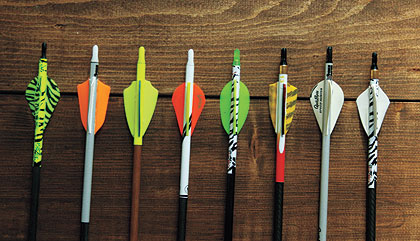
Fibreglass arrows come in many shapes and sizes. They can be customized for particular shooting styles or bow setups.
Choosing your fletching shape involves some options. You can pick shield-cut, parabolic-cut, or straight fletching, which is also called helical.
Shield-cut fletchings offer a larger surface area which helps stabilize the arrow quickly upon release but may create more drag during flight.
Parabolic
Parabolic fletchings strike a balance between stability and reduced drag by providing a moderate surface area for stabilization without excessive wind resistance.
Straight or helical
Straight or helical fletchings spin the arrow in flight. This spin improves stability over long distances.
The right fletching material, shape, and style depend on your needs and bow setup. Trying out different combinations can help you find the best fit. You may like the look of feather fletching or the technology of plastic vanes.
Knowing how fletching affects arrow flight is key. It helps you make a good choice when picking your archery arrows.
Arrow Nocks
The arrow nock is a small, grooved piece at the back end of the arrow that fits onto the bowstring.
It plays a crucial role in ensuring proper alignment and release, making it an essential part of your archery equipment.
First off, let’s talk about different types of arrow nocks.

Traditional archery often utilizes self-nocks, which are simply notches cut directly into the back end of wooden arrows. These nocks provide a classic aesthetic and are suitable for those who prefer traditional archery.
However, they may be less durable compared to their modern counterparts. For compound bow arrows or carbon arrows used in various types of archery such as recurve bows or longbows, there are two main types of nocks: index-type and throat-type.
Index Nocks
Index nocks have a small index vane that aligns with the bowstring serving as a reference point for consistent positioning.
Throat Nocks
On the other hand, throat-type nocks have a deeper groove that engulfs more of the string and offers added security.
Additionally, some modern arrow accessories allow for adjustable or interchangeable nocks. These allow you to fine-tune your setup based on personal preference or specific shooting conditions.
By experimenting with different types of arrow nocks, you can optimize your performance and achieve greater accuracy on the range or in the field.
While often overlooked, arrow nocks play an important role in achieving consistent and accurate shots.
Arrow Heads
When it comes to arrow points, there is a wide variety of options to choose from, each with its own unique purpose and characteristics.
The type of point you select can significantly impact your performance in archery or hunting. Let’s delve into the different arrow point options available and explore their features.
Field Points
Field points are specifically designed tips that allow you to practice your archery skills effectively and safely. They are primarily used in target shooting and 3D archery.
They are typically made from steel or other sturdy materials to withstand repeated impacts on targets without getting damaged.
These points are available in different weights, ranging from 80 grains to over 200 grains, allowing you to customize your arrow’s weight.
The shape of field points can vary as well. The most common design resembles a bullet, with a smooth round tip that minimizes damage to targets while offering reliable accuracy.
Some field points come with screw-in attachments for easy replacement when needed.
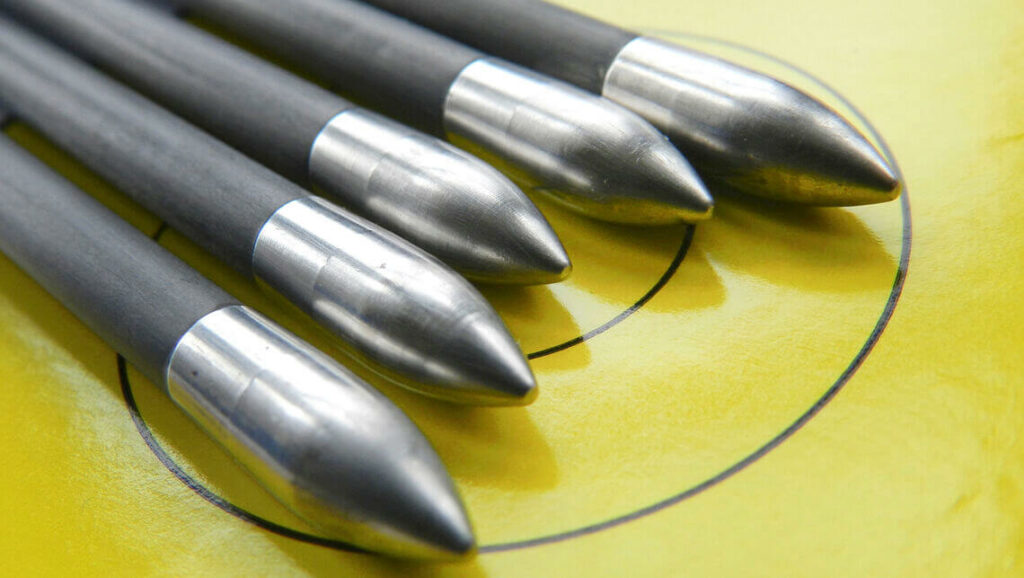
Why Should You Consider Using Field Points?
Consistency
Well, they provide consistent flight characteristics due to their aerodynamic design. This means that when practising with field points, you can trust that each shot will behave similarly, helping you improve your form and aim over time.
Cost
Using field points also has another advantage – cost-effectiveness. Since these tips are specifically designed for target practice rather than hunting, they tend to be more affordable compared to other types of specialized arrowheads like broadheads or mechanical heads.
It’s worth mentioning that using field points allows you to preserve the longevity of your arrows.
When practising with broadheads or other hunting-specific arrowheads repeatedly, there’s a higher chance of damaging or dulling them prematurely.
Broadheads
Broadheads are an essential component of archery when it comes to hunting. These specialized arrow tips are designed to deliver maximum damage and ensure a clean, ethical kill.
There are various types of broadheads available, each with its own unique features and advantages. One popular type of broadhead is the fixed-blade broadhead.
As the name suggests, these broadheads have blades that remain fixed in position, providing stability and delivering consistent penetration upon impact.
The number of blades can vary, with options ranging from two to four blades.
Fixed-blade broadheads remain intact after hitting the target. This makes them ideal for large game hunting.
However, mechanical or expandable broadheads are becoming more popular. They offer great accuracy and a wider range.

These broadheads feature blades that remain closed during flight but deploy upon impact, causing maximum damage to the target.
This design not only enhances accuracy but also creates larger wound channels for quicker kills.
When selecting broadheads for your arrows, it is crucial to consider factors such as blade sharpness, cutting diameter, and weight.
Blade sharpness ensures effective penetration while minimizing suffering for the animal being hunted.
A broader cutting diameter increases blood loss and increases the chances of a successful hunt.
Furthermore, choosing a broadhead with an appropriate weight that matches your bow’s draw weight and performance helps maintain optimum arrow flight.
Blunt Points
When it comes to archery, there’s more to arrows than just sharp and pointy tips. Blunt points are a unique type of arrowhead that serve a specific purpose.
Unlike their sharp-edged counterparts, blunt points are designed for target shooting and small-game hunting.
They are blunt (hence the name) and rounded at the tip, which helps prevent penetration upon impact.
Blunt points are perfect when you want to practice aim but not damage targets. If you’re planning a fun competition or just shooting cans in your yard, choose blunt points
They can be used with various types of arrows, including carbon arrows or traditional archery arrows.
The primary advantage of using blunt points is their ability to absorb impact energy upon hitting a target.
Instead of piercing through the object like sharp arrowheads would, blunt points distribute the force across a larger surface area.
This reduces the risk of causing harm or destroying valuable equipment like targets or backstops.
Blunt points have another advantage. They lower the risk of losing arrows in thick bushes when hunting small game.
They don’t go deep into animals or get stuck in heavy foliage like other arrowheads. This makes them easier to find after hitting the target.
Bowfishing Spear Points (Grabbing Points)
When it comes to bow fishing, the type of arrow you need is quite different from what you would use for target practice or hunting.
That’s where bow-fishing points come into play.
These specialized points are designed specifically for piercing fish and securing them on your line. typically have barbs or prongs that prevent the fish from slipping off once they’re skewered.
This is crucial because, unlike traditional archery arrows, where you aim to take down your target with a clean kill shot, bow fishing involves capturing fish alive. The barbs ensure that the fish stays hooked until you can pull it in.
You’ll be shooting these arrows into water, possibly hitting rocks or hard surfaces below. They need to resist impact and not break easily.

Bowfishing spear points are often made of tough materials like stainless steel or reinforced plastic. This helps them stand up to the demands of underwater shooting.
When selecting a bow fishing spear point, consider its shape as well.
Some models have a classic broadhead design. They have large cutting edges and sharp tips for the best penetration.
Others might have unique designs like double-barbed or grapple-style points. These are excellent for catching larger fish species.
If you’re venturing into the world of bow fishing, don’t forget about getting yourself some reliable bow fishing spear points.
These purpose-built accessories will increase your chances of successfully reeling in those slippery aquatic targets by providing both effective penetration and secure retention.
So get out there and enjoy this unique variation of archery while bagging some impressive catches along the way!
How to Determine the Best Arrow Weight
When it comes to determining the best arrow weight for your bow, there are a few factors you need to consider.
Draw Weight
Different bows have different draw weights, so it’s essential to know what yours is before choosing an arrow weight.
If you have a lighter draw weight, you’ll typically want lighter arrows, while heavier draw weights require heavier arrows for optimal performance.
Arrow Speed
If you’re looking for faster shots and flatter trajectories, lighter arrows are usually the way to go.
They offer less resistance and can achieve higher speeds when shot from a bow. On the other hand, if accuracy and stability are more important to you than speed, then heavier arrows might be a better choice.
They tend to be more forgiving and can help compensate for any inconsistencies in your shooting form.
Your Purpose
If you’re primarily into target shooting or participating in competitions, precision and consistency are key factors.
In such cases, selecting an arrow weight that allows you to maintain a steady aim without experiencing excessive fatigue will be beneficial.
However, if hunting is your main focus with traditional archery or compound bows, penetration power becomes paramount as you want an arrow that delivers sufficient force upon impact.
Ultimately, finding the right arrow weight may require some experimentation and fine-tuning based on personal preferences and shooting style.
It’s recommended to consult with experienced archers or seek advice from professionals at archery stores who can provide guidance based on your specific requirements and equipment setup.
Remember that selecting the ideal arrow weight goes hand in hand with understanding how it complements your bow’s characteristics and enhances performance during various archery activities – whether it’s achieving tight groupings on targets or delivering effective kills during hunts.
Conclusion
Selecting the right type of arrow is essential for a successful and enjoyable archery experience.
With a vast array of options available, it can be overwhelming to determine which arrows are best suited for your specific needs.
By understanding arrow components such as fletching types, nock styles, and arrowhead options (from broadheads to field points), and determining suitable arrow weights based on your equipment setup – you can ensure that your archery experience is both successful and fulfilling.
So, equip yourself with the right arrows and accessories, embrace the joy of shooting, and let your arrows fly true!

0 Comments